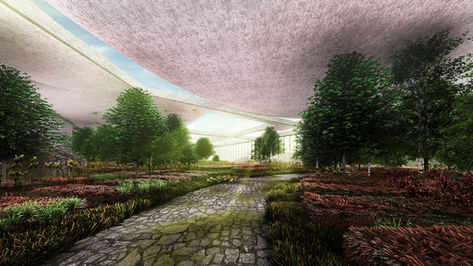top of page



fka-design
2022
Tuscany, Italy
Competition
research, landscape, large scale, architecture, residential, hospitality, factory, laboratory, design
Natural Datascape
design studio
year
location
client
categories
Natural Datascape reimagines the European pastoral landscape not as a nostalgic return to agrarian life, but as a complex system shaped by ecological intelligence and digital infrastructure. This project asks how traditional farmlands can evolve into responsive terrains that fuse plant life, data, and human activity. What emerges is a landscape that performs, calculates, and cultivates simultaneously.
The familiar image of hedgerows, orchards, and tilled fields remains present, but these elements are embedded with technological operations. Moisture levels are monitored in real time. Crops are scanned for stress signals. Pollinator patterns are tracked by drones. Subsurface irrigation systems respond to climate data to conserve water and optimize yield. The pastoral becomes a performance, a living field of interlinked systems constantly adjusting to new inputs.
As societies and cultures have developed in modern times, we have generated vast amounts of waste and depleted many of our natural resources. At the same time, digital technologies have become central to our social interactions and systems of knowledge. We store and accumulate digital information like geological strata, yet this accumulation is far from weightless. It consumes energy, produces heat, and reshapes the physical world. The digital world is not immaterial. It is resource-hungry and materially rooted.
Natural Datascape engages this reality by juxtaposing the digital, the human, and the ecological to form a post-human ecosystem. It imagines a condition where physical and digital processes collide, producing a new understanding of life in the post-Anthropocene. Within this framework, a subterranean data center becomes the thermal engine for a greenhouse above. The heat produced by servers is captured and redirected to support plant growth. Surface pools of water act as both heat sinks and aesthetic features, controlling temperature while creating reflective and ecological moments across the site.
The data center is reinterpreted as a farm. This inversion turns a symbol of extraction and isolation into a landscape of cohabitation and renewal. Familiar pastoral geometries such as rows, terraces, and hedges are reimagined as expressive surfaces, revealing the presence of computational systems beneath. The landscape becomes a performative field that stores, transforms, and releases energy across human and non-human scales.
Programmatically, the site is divided into zones for research, training, and modular expansion. These spaces adapt over time, responding to the growing demand for data and the evolving needs of the ecological system it supports. This is not a fixed masterplan but a reactive environment structured by inputs, feedback loops, and material consequences.
By revealing the operations of data and energy systems within a recognizable rural setting, Natural Datascape challenges the illusion of technological invisibility. It asks what it means to cultivate land in the age of information. It questions how we define nature, labor, and productivity when every plant may function as a sensor and every hill may shelter a server.
This project offers a vision of a new rural imaginary. It does not separate tradition from innovation or nature from infrastructure. It proposes a landscape where agriculture, architecture, and information systems are intertwined. The land is not only seen, but read. Not only worked, but computed. And not only sustained, but designed.
bottom of page






























